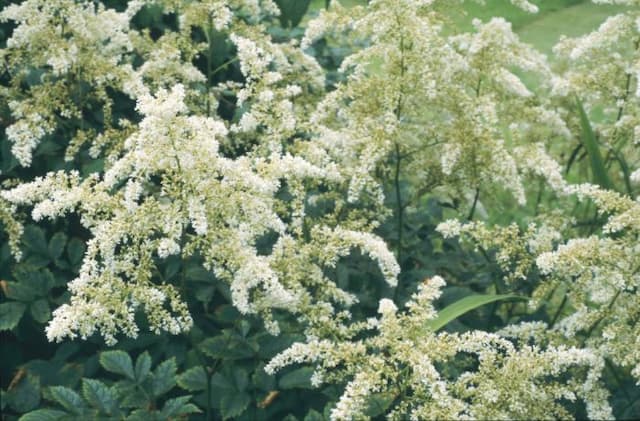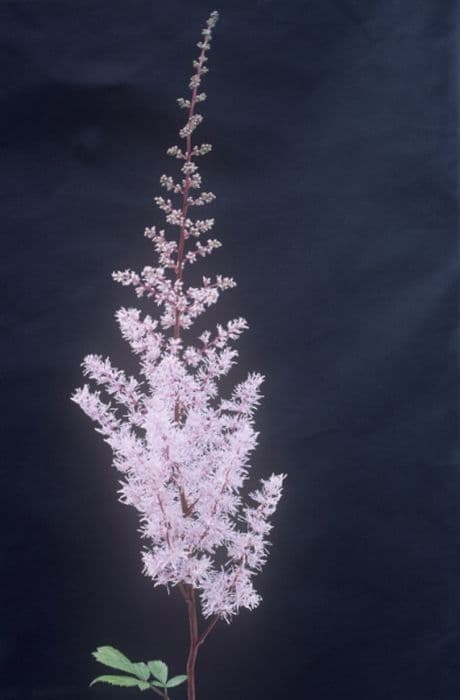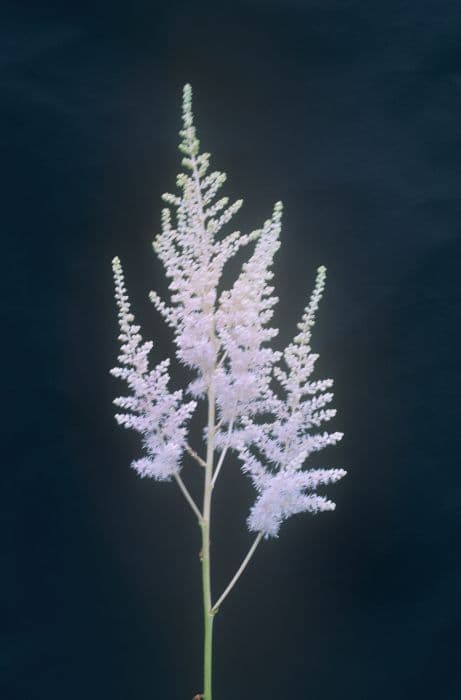Wada's Saxifrage Saxifraga 'Wada' (fortunei) (5)

ABOUT
The Saxifraga 'Wada', also commonly known as the Fortune's Saxifrage, is a charming perennial plant that boasts a lush mound of attractive foliage and delightful blooms. The leaves of this Saxifrage are typically bright green, forming a dense, tightly knit rosette. The foliage often has a slightly hairy texture, providing a soft and tactile experience. As the plant matures, it produces sprays of small, star-shaped flowers that rise above the foliage on thin, yet sturdy stalks. These blossoms are commonly found in shades ranging from white to soft pink, often with subtle dots or markings that add to their ornamental appeal. The flowers are arranged in loose clusters, creating a frothy and delicate display that can add a touch of whimsy to any garden setting. The overall impression of the Saxifraga 'Wada' is one of a low-growing, mat-forming plant that invites close inspection to appreciate its intricate details. Its bloom time adds to its charm, as it typically flowers during the spring and early summer months, bringing a fresh burst of life and color after the winter season.
About this plant
 Names
NamesFamily
Saxifragaceae
Synonyms
Wada's Saxifrage, Fortune's Saxifrage
Common names
Saxifraga fortunei, Saxifraga fortunei var. alpina, Saxifraga fortunei var. panchtharica.
 Toxicity
ToxicityTo humans
The plant commonly known as Saxifrage is not known to be toxic to humans. There are generally no symptoms of poisoning as it is not considered a plant that poses a risk when touched or ingested in the normal course of handling or gardening. However, it is always advisable to avoid ingesting any plant material unless it is known to be safe and is intended for consumption.
To pets
The plant commonly known as Saxifrage is not known to be toxic to pets. It is not typically associated with symptoms of poisoning in animals such as dogs or cats. The Saxifrage is generally considered safe around pets, and there should be no adverse consequences if a pet happens to ingest parts of this plant. However, as with any non-food plant, consumption in large quantities might cause mild gastrointestinal irritation or upset, so it is always best to keep an eye on pets and prevent them from eating ornamental plants.
 Characteristics
CharacteristicsLife cycle
Perennials
Foliage type
Evergreen
Color of leaves
Green
Flower color
White
Height
1 foot 2 inches (0.36 meters)
Spread
1 foot (0.30 meters)
Plant type
Herb
Hardiness zones
6
Native area
Japan
Benefits
 General Benefits
General Benefits- Aesthetic Appeal: Saxifraga 'Wada' adds visual interest to gardens with its attractive foliage and star-shaped flowers.
- Low Maintenance: Being a hardy perennial, it requires minimal care once established, making it ideal for busy gardeners.
- Drought Tolerance: It can survive in drier conditions once fully grown, which reduces the need for frequent watering.
- Attracts Pollinators: The flowers attract bees, butterflies, and other beneficial insects, supporting biodiversity.
- Groundcover: It can act as a natural weed suppressant thanks to its mat-forming habit, reducing the need for herbicides.
- Rock Gardens: Ideal for rockeries or alpine gardens due to its compact size and ability to thrive in rocky, well-draining soils.
- Seasonal Interest: Provides visual interest throughout the growing season with its evergreen leaves and spring-to-summer blooming period.
 Medical Properties
Medical PropertiesThis plant is not used for medical purposes.
 Air-purifying Qualities
Air-purifying QualitiesThis plant is not specifically known for air purifying qualities.
 Other Uses
Other Uses- Saxifraga 'Wada' can be used in miniature or fairy gardens due to its small size and delicate appearance, adding a touch of whimsy and fantasy to the setting.
- Due to its striking foliage, this plant is suitable as a subject in botanical illustration and plant photography, capturing the beauty of its leaves and growth habit.
- This variety, with its dense, mat-forming habit, can be employed as a living mulch to suppress weeds and maintain soil moisture in garden beds.
- Saxifraga 'Wada' can be utilized in educational settings like schools or botanical gardens for teaching plant growth patterns and adaptation in alpine plants.
- With its tolerance for cold, it can be planted in outdoor container gardens to provide year-round interest, especially in regions with cooler climates.
- The plant can be used in green roofing or living roof projects, where it can aid in insulation and creating habitats for insects.
- Its resilient nature makes it suitable for use in rock crevices or stone walls, where it can help stabilize the structure and prevent erosion.
- As a groundcover, Saxifraga 'Wada' can be used in slope and bank landscaping to create an attractive and low-maintenance solution for challenging terrains.
- The plant's ability to grow in shallow soil makes it ideal for embedding in hypertufa pots and garden ornaments for a naturalistic look.
- For bonsai enthusiasts, Saxifraga 'Wada' can offer an alternative plant choice for creating kusamono or shitakusa, the complementary plantings that accompany bonsai displays.
Interesting Facts
 Feng Shui
Feng ShuiThe Saxifrage is not used in Feng Shui practice.
 Zodiac Sign Compitability
Zodiac Sign CompitabilityThe Saxifrage is not used in astrology practice.
 Plant Symbolism
Plant Symbolism- Tenacity: Named for the Latin word "saxifraga" which means "stone-breaker," this plant is often symbolic of determination and tenacity, as it can grow in rocky and tough environments.
- Perseverance: Its ability to thrive in difficult conditions makes it a symbol of perseverance and the ability to overcome challenges.
- Adaptability: As it is a plant that adapts to various environments, the Saxifraga is often associated with adaptability and versatility in life.
- Protection: In some traditions, Saxifraga plants are believed to offer protection because they are capable of surviving in places where other plants cannot, suggesting a strong life force.
- Purity: The often white and delicate flowers of the Saxifraga may symbolize purity and innocence.
 Water
WaterThe Strawberry Begonia, as Saxifraga 'Wada' is commonly known, prefers to be watered regularly to maintain evenly moist soil. Water the plant thoroughly when the top inch of soil feels dry to the touch, which can be about once a week depending on environmental conditions. Pour water evenly around the base of the plant until it begins to drain from the bottom of the pot. Avoid letting the plant sit in standing water as this can lead to root rot. Depending on the pot size and the indoor climate, this typically equates to around 8-16 ounces of water each week.
 Light
LightStrawberry Begonia thrives in bright, indirect light. A spot near a north-facing or east-facing window where it can receive plenty of light without direct sun is ideal. Avoid placing it in full sun as it can cause leaf burn, and too much shade can result in leggy growth and fewer flowers.
 Temperature
TemperatureStrawberry Begonia prefers a cool to average range of temperatures, ideally between 60 to 75 degrees Fahrenheit. It can tolerate temperatures as low as 50 degrees Fahrenheit but should be protected from frost and extreme heat above 80 degrees Fahrenheit. Offering a stable temperature without sudden drops or spikes is crucial for its health.
 Pruning
PruningPruning Strawberry Begonia helps to maintain its shape and remove any dead or yellowing leaves. Prune lightly after flowering to encourage bushier growth, which is typically in the late spring or early summer. It's sufficient to prune once a year, or as needed, to remove spent flowers and any leggy stems to keep the plant looking tidy.
 Cleaning
CleaningAs needed
 Soil
SoilThe best soil mix for the Fortune Saxifrage consists of a combination of peat, coarse sand, and compost in equal parts, ensuring well-draining and moisture-retentive properties; the ideal soil pH should range between 5.5 and 7.
 Repotting
RepottingFortune Saxifrage should be repotted every two to three years to refresh the soil and provide room for growth, preferably in the spring before the plant enters its active growing phase.
 Humidity & Misting
Humidity & MistingFortune Saxifrage thrives in moderate humidity levels, ideally between 50% and 70%, as too dry conditions can cause stress, whereas excessive humidity can promote rot.
 Suitable locations
Suitable locationsIndoor
Ensure bright, indirect light and cool temps.
Outdoor
Plant in dappled shade and well-draining soil.
Hardiness zone
6-8 USDA
 Life cycle
Life cycleSaxifraga 'Wada' begins its life as a seed, typically germinating in cool, moist conditions in spring. After sprouting, it develops into a young plant, with its foliage forming a basal rosette close to the ground. As it matures, the plant grows a sturdy flower stalk that produces clusters of small, star-shaped flowers, usually blooming in late spring to early summer. Following pollination, which is often aided by insects, the flowers develop into seed capsules, dispersing seeds for the next generation. During the growing season, this perennial expands by forming offsets, creating a denser clump. In winter, the plant enters a dormancy phase, with its leaves often persisting, ready to regrow the following spring.
 Propogation
PropogationPropogation time
Spring to early summer
Saxifraga 'Wada', often referred to as Wada's Saxifrage, is best propagated using the division method, allowing gardeners to create new plants by separating a mature plant into smaller pieces. The ideal time for this method is in the spring, just as the plant begins to show new growth, which gives the divisions a full growing season to establish themselves. To propagate by division, carefully dig up the entire plant, making sure to preserve as much of the root system as possible. Gently tease apart the clumps into smaller sections, each with a portion of the root system and several shoots. Replant these divisions at the same depth they were originally growing, spacing them about 12 inches (approximately 30 centimeters) apart to allow for future growth. Immediate watering after planting helps settle the soil and reduces stress on the newly planted divisions.









